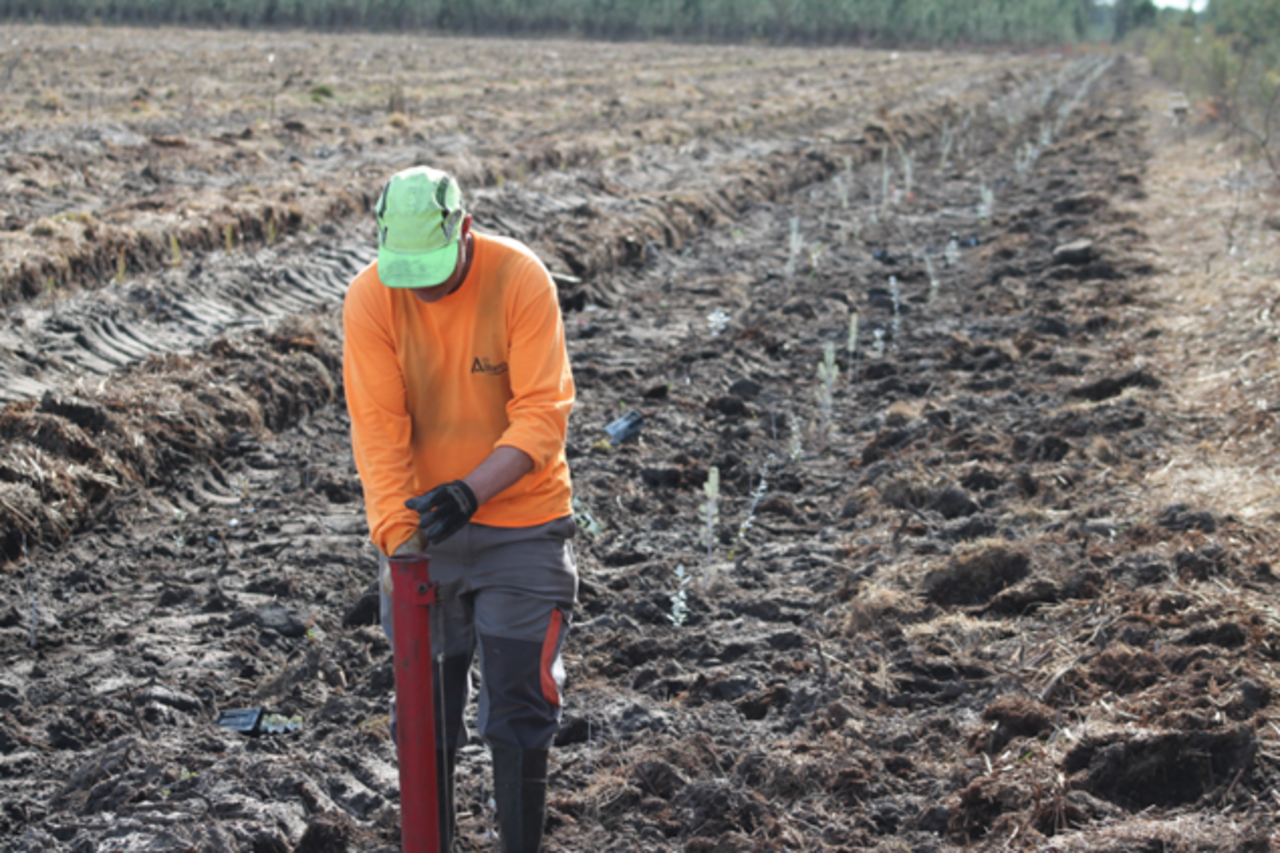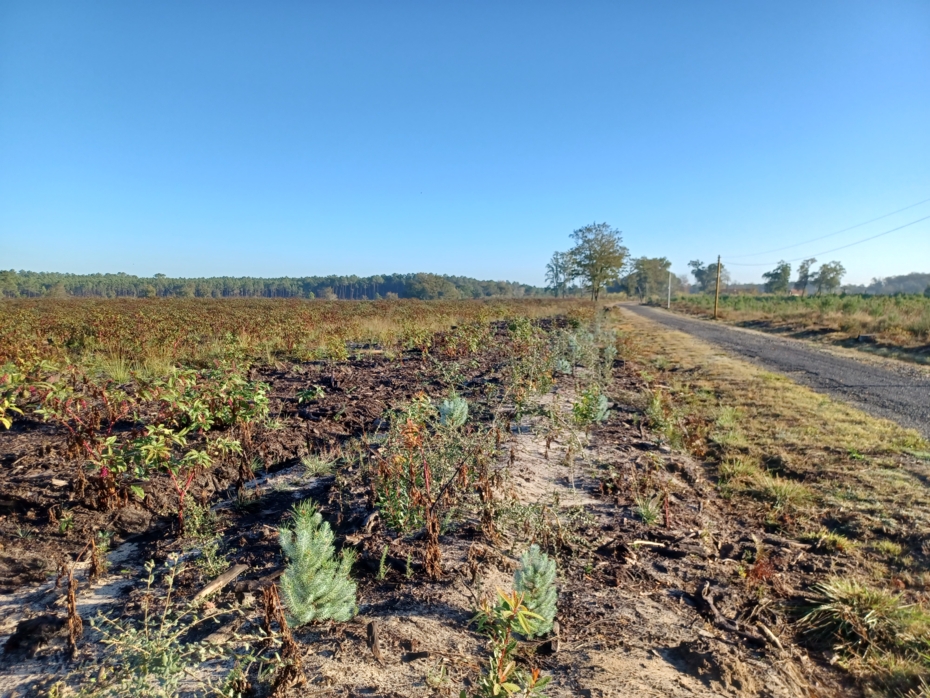Planting of hardwood hedgerows
A method to diversify productive monoculture of maritime pine

Plantation of a broadleaved hedgerow along a maritime pine plantation in Luxey, France ©AFB
This good practice explains the technical implications of establishing a broadleaved hedgerow. In the Landes of Gascony Forest, one of Europe's largest man-made forests, SUPERB-BOCAGE tackled the challenge of transitioning from intensive, profit-oriented pine monoculture management to more resilient and biodiversity-friendly practices. Using a living lab approach, stakeholders collaboratively designed and implemented innovative solutions, including the installation of diversified broadleaved hedgerows alongside maritime pine plantations.
Context:
The Landes of Gascony Forest is one of the largest man-made forests in Europe. The million hectares of maritime pine plantations and almost two centuries of its existence have shaped a very strong forestry culture among the population. The maritime pine (Pinus pinaster) is a native species that cope remarkably well with the poor sandy and acidic soils that characterize this region, but also with summer drought, winter waterlogging, moderate cold and variable rainfall (from 700 to 1400 mm of annual rainfall). A dedicated breeding program launched in the 60s has improved its growth in height and diameter, as well as its stem, branching and wood quality over more than 3 generations of seed orchards. Combined with an optimization of silvicultural techniques (mechanisation, plantation, production of seedlings, phosphate fertilization and the reduction of the rotation length), the average annual productivity of the maritime pine species has nearly tripled in 50 years. It has thus become a species of major socio-economic interest, both regionally and nationally. Today, the maritime pine covers 90% of the Landes of Gascony forested area, mainly in pure stands. However, this landscape homogeneity makes it vulnerable to attack by insects and pathogens, the risks of which are increasing as a result of global change, to which is added increased vulnerability to the risk of storm or wildfire when age classes are homogeneous over large areas. It is essential to make the pine forest more resilient in order to maintain its wood production and continue to fuel the ecological transition.
Problem Description:
The Landes of Gascony Forest is characterized by highly intensive and optimized management, yet growing threats to the forest ecosystem and socio-economic resilience have raised concerns about changing the established management methods. Even the biggest disturbances in the past, such as the storms of 1999 and 2009 which damaged 60% of the area, were not enough to bring about a change towards more resilient or diversified forest management practices, due to the lack of consolidated alternatives. The recent large scale forest fire we suffered in 2022 is the latest dramatic opportunity to rethink our forest management system and landscape restoration.
One of the biggest challenges is to figure out how to initiate changes in forest practices to better protect biodiversity and ecosystems while working within an already highly optimized and profit-oriented system. The scientific community is often very effective in diagnosing the weaknesses of our agricultural and forestry models and in devising new solutions. However, the transition from a poorly resilient, but commonly accepted state, to a better adapted but hypothetical state often comes up against realities on the ground. This include adapting the wood-production oriented management, selecting other adapted species to the poor sandy soils, overcoming legislative barriers or confronting the different expectations of local stakeholders. The proposed solution of planting only hedegerows of deciduous trees is easy to understand and implement, without compromising the productive management of maritime pine.
Implementation Steps:
Step 1: Selection of adapted species to the local, ecological and socio-economic context
The choice of tree species to use for forest restoration can be particularly critical, as it is subject to a variety of personal sensibilities and experiences. We opted for the implementation of a participatory process to benefit from local knowledge and ensure stakeholder support in the restoration activity. The process is described in the stakeholder engagement section.
Step 2: Plant production and delivery
The reintroduction of hardwood species requires them to be planted and therefore produced in nurseries. This stage must be anticipated as early as possible, as the seed supply and seedling production can take several years, particularly in the case of less common species. Moreover, it is preferable to have the seedlings of the different species sold mixed in their transport boxes to facilitate the work of the planter, who simply takes the plants as they come. Otherwise, a forestry engineer may have to ensure that the plantation is following a mixed tree species pattern.
Step 3: Design the plantation scheme and modalities
The design of the planting scheme depends on ecological and economic considerations to determine planting area, width and density. It is a trade-off between the loss of profitable area allocated to diversification and the creation of a coherent, functional habitat. In our demo, we opted for a rather dense plantation density to create a shady, moist environment, but over a rather narrow width of 3 to 4m to limit the negative economic impact. To lower the costs of the restoration action, it was also decided to use chemical protection against game pressure compared to physical individual protection, to let the hedgerow unmanaged, and to maintain a gap every 100 meters to facilitate access for firefighters.
Step 4: Soil preparation and plantation
The soil was prepared in the same way as for the pine plantation by ploughing. Usually, the optimal time to plant hardwoods is during winter. The species used needs to be adapted based on the soil type and water table on site. The results of the replicated experiments allow us to make the following recommendations:
- Wet heathlands with frequent waterlogging: Frangula alnus, Betulan pendula, Aulnus glutinosa, Betula pubescens
- Rehabilitated wet heathlands: Pyrus pyraster, Betula pendula, Rhamnus frangula, Sorbus aucuparia, Sorbus torminalis, Arbutus unedo, Frangula alnus
- Mesophilic heathlands: Quercus suber, Betula pendula, Arbutus unedo, Pyrus pyraster, Sorbus aucuparia, Sorbus torminalis, Sorbus domestica, Frangula alnus
- Dry heathlands: Quercus suber, Quercus ilex, Quercus pyrenaica, Pinus pinea, Arbutus unedo
Stakeholder Engagement:
We applied multicriteria decision analysis (MCDA) as a collaborative and rational method to select the tree species to be included in the restored hedgerows. We’ve set a preliminary list of potential adapted tree species based on historical observations. Each stakeholder was asked to evaluate multiple, conflicting criteria (native/exotic status, survival rate, biodiversity habitat, seed supply, landscape aesthetics and many more to be adapted to the local context) for each tree species. We obtained a list of ten preferred species whose use is to be adapted according to the soil and water table micro-conditions.
Knowledge Types:
Local and practical knowledge were both used in the first step of the implementation process. Indeed, the knowledge gained over time by the local communities living in the demo area and the practitioners running their own experiments or forest management was valuable to assess the relevance of the bunch of tree species to be tested within the hedgerows.
Scientific knowledge is used in the monitoring of each year’s hedgerows experimental plantings. It consists in collecting data about the survival rate, drought and game damage, as well as the growing rate. These measures are then processed to the species plantation recommendations.
Replicability:
NO, the practice has been tested only in the same context and scale; it needs to be proven for replicability and adaptability to various contexts.Key Success Factors:
- The concept of hedgerow implies to work on the interstices (e.g. the edge between two plots or between a plot and an infrastructure like roads or firebreaks). It’s an area that is easier to work with and interferes very little with the rest of the silvicultural management in the plot, which is easier for the owner and its manager to accept, especially in a highly productivist cultural context. Secondly, edges are the areas most exposed to external hazards in a forest plot. Transforming them into unmanaged, self-maintaining and diversified hardwood species hedgerows ensures greater protection of the productive stand against the risks of storms or pest outbreaks. Finally, linear deciduous hedgerows can more easily be assimilated to an infrastructure, like a green network, in the same way as the network of roads and firebreaks to combat the risk of fire. As such, they become more visible in the landscape, better identified by local stakeholders, making it easier to enforce conservation and restoration regulations and funding measures.
- The scientific monitoring protocol comparing plots with and without deciduous hedgerows emphasized both the richness of biodiversity and its functional interest in regulating local insect pests. This gave arguments to both environmental associations and forest managers about the benefits of these hedgerows for their own interests. It also helped specify the upscaling strategy: promoting the restoration in areas with low density of broadleaved species has a greater impact than improving habitats connectivity
Common Constraints:
Barrier in step 1 of the implementation: some newly adapted species identified as good candidates for the plantation of hedgerows did not belong to the official list of Forestry Reforestation Material, which gives access to public funding. As a result, new restoration projects would not have been able to benefit from the current replanting subsidies, which would have been detrimental to the upscaling of the method. The inclusion of regional policy makers to the demo workshops, and close discussions have led this FRM list being amended to include our new native species.
Lessons Learnt:
- Strong need to ensure broad stakeholder representation to benefit from all their experience and meet the widest possible range of expectations
- Explore the best compromise between ecological benefits, social expectations and the economic interests of landowners
- Tackle legal bottlenecks to avoid deployment limitations and facilitate reproducibility
- Anticiapte nursery production as much as possible, especially when it comes to less common species
Positive Impacts:
- Increased diversity of habitats including micro-habitats
- Increased landscape diversity
- Increased old-growth attributes, e.g. veteran trees
- Increased structural diversity
- Increased tree species diversity
Increased diversity of habitats including micro-habitats: Every type of dendro-micro-habitats on all large trees of the hedgerow were surveyed according to Larrieu et al. (2018). Trees in deciduous hedgerows are on average 3 to 4 times richer in micro-habitats than those in pine borders. The mosses, lichens, dead wood, polypores, ivy and cavities found on oak trees are indirect indicators of their capacity to host biodiversity. This capacity increases with age and trunk diameter.
Increased structural diversity: the restoration activity consists in planting a diversity of seedlings, including tall trees and shrubby species. We are therefore favouring an important structural diversity of the newly installed hedgerows. Moreover, this permanent hedgerow will diversify the structural diversity at the stand scale, by diversifying the structure of the even-aged maritime pine plantations.
Increased old-growth attributes, e.g. veteran trees: the objective of the restoration activity is to leave the newly installed hedgerows unmanaged, which should enable certain dominant species to acquire old-growth attributes in 70 years’ time.
Increased tree species diversity: we try to introduce at least 5 different species in the hedgerows, depending on the seedling’s availability in local nurseries and on the soil type and water table. Thus, the stand scale tree species diversity increases from 1 species (monoculture of maritime pine) to at least 6 species.
Negative Impacts:
- Reduced timber quality or quantity
Reduced timber quality or quantity: Loss of between 2% and 8% of the stand's productive area (depending on the size and shape of the stand)
Media
- Active Restoration
- Implementation
- Integrative Forest Management
- Landowners & Practitioners
- Planners & Implementers
- Afforestation, reforestation
- Structural diversity
- Tree species/functional diversity
- Atlantic
- France
- Economic
- 10 km


